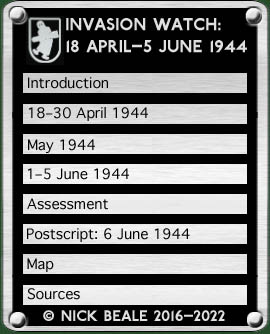|
24 May The Luftwaffe finally seemed to recover some determination to secure coverage of British targets. During the afternoon, 4.(F)/123 was able to photograph Poole and Christchurch Harbours, for the first time since 12 August and 18 March 1943 respectively. Substantial numbers of landing craft were identified at Poole as well as 13 “objects afloat.” There were no vessels at Christchurch but 28 single- and nine twin-engined aircraft on the airfield there. Six days later, a full evaluation of the pictures downgraded the initial estimates—the total shipping seen would suffice for 1.3 landing formations and in particular there were no LCT in Poole. Further east, two Bf 109 of the 5. Staffel were aloft from 1346–1525 and were able to photograph the strips Foulness – Eastchurch – Whitstable – Canterbury and Canterbury – Adisham – Dover – Folkestone. In addition they got pictures of Folkestone and Dover Harbours (which they compared with those taken on 26 July 1943). The airfield at Canterbury (last visited on 2 November 1942 apparently) was partially covered by cloud and no aircraft could be made out. The mass of shipping identified at Dover included six Motor Torpedo Boats, 18 minelayers and four LCT (Landing Craft Tank). Fremde Heere West summed up recent developments and, in passing, demonstrated how long some ports had been left by the Luftwaffe without coverage: Aerial reconnaissance of the English south coast on 24 May showed a considerable increase in landing vessels in the Weymouth-Portland area compared to the most recent reconnaissance on 20 January. Increase from 80 to 1200 loads. Just as there was an increase in Poole compared with the last reconnaissance of 12 August 1943, in Folkestone and Dover there was only a minor increase in landing vessels ascertained compared to 26 July 1943. Since 24 April the following landing craft transportation capacity had been seen:
On top of this, shipping capacity for the loading of 6½ divisions had been detected, bring the total capacity to 16½ and: These reconnaissance results show once again the comprehensive preparation of landing ship capacity on the English south coast whereas aerial reconnaissance of the harbours of North East Scotland no landing vessels have been seen to date. This knowledge underlines the current decline in the significance of Northern Scotland compared to the jumping-off preparations on the southern and south western coastal areas of England. The day proved costly for 4.(F)/123. The 21 year-old Uffz. Heinz Luginger (Bf 109 G-5, W.Nr. 27108) was shot down and killed by German Flak near Lison (15 km SE Carentan) and Bf 109 G-6, W.Nr. 20373 crashed outside Équemauville (just west of Honfleur) and was 10% damaged although Obltn. Hedrich emerged unscathed. One of these incidents may explain why one aircraft was called continuously by its controllers from 1037 GMT.
An Fw 190 F-1, W.Nr. 5619, was ferried from its former owner, 1./NAG 13, to the 2. Staffel; this machine was armed with 2 x MG 17 and 2 x MG 151/20 but its radio set and camera had been removed. The 3./NAG 13’s Bf 109 G-8, W.Nr. 710061 was destroyed in a crash following an engine fire. An innovation that night — perhaps reflecting a heightened sense of urgency — was the use of II./KG 51 and I./SKG 10 for shipping reconnaissance. From the former unit, four Me 410 took off from 0124 and from the latter four Fw 190 for the area Fécamp – Brighton – North Foreland – Dunkirk. British radar reported enemy aircraft between Sandwich and Beachy Head and between Selsey Bill and Isle of Wight from 0231–0315, one of which was overland at Hythe for about two minutes. The Germans achieved no more than sightings of shipping south of Beachy Head but ADGB commented that:
25–26 May Two aircraft were detected NW of Guernsey during the evening. These proceeded to about 30 km south of Start Point, took up a north-easterly course for another 25 minutes and then turned for home at 1917 GMT. In an air raid on 5.(F)/123’s base of Monchy-Breton, Fw 190 A-5, W.Nr. 190.015.2662, (black?) “16” suffered damage to its fuselage, tail unit, main plane, landing gear, engine and airscrew. Five days later it was handed over to the AGO workshops at Cravant-Bazarnes and its airframe was still there when the Allies inspected the site in October. It was documented as KM+EX, built by Focke-Wulf, Bremen, rebuilt by AGO, Oschersleben in 1943, and received for repair on 6 June. This Focke-Wulf had been passed over to 5.(F)/123 on 10 April but it is not clear from whom. NAG 13 was informed on the 25th of the allocation of a Fi 156 C-3, W.Nr. 5575, which it must however collect from Herzogenaurach. The 26th brought no more than R/T traffic suggesting that 4.(F)/123 may have been active during the afternoon and evening. continued on next page …
|
||||||||||||||||||||||||


